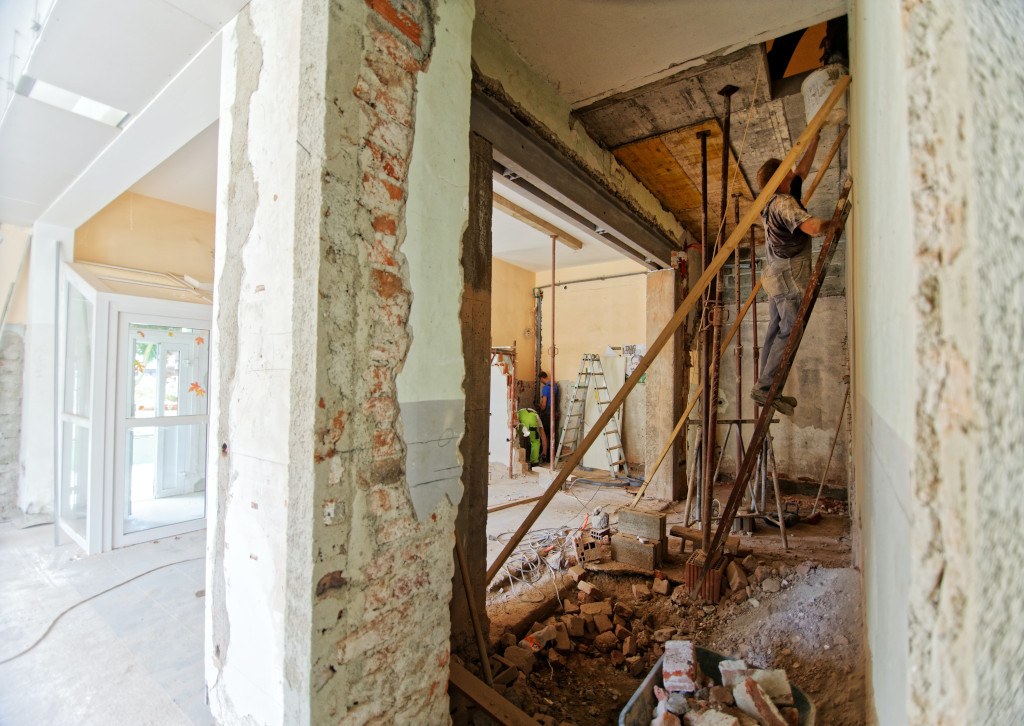Using Technology to Slash the Time It Takes to Deliver Accurate Takeoffs With Carroll Estimating
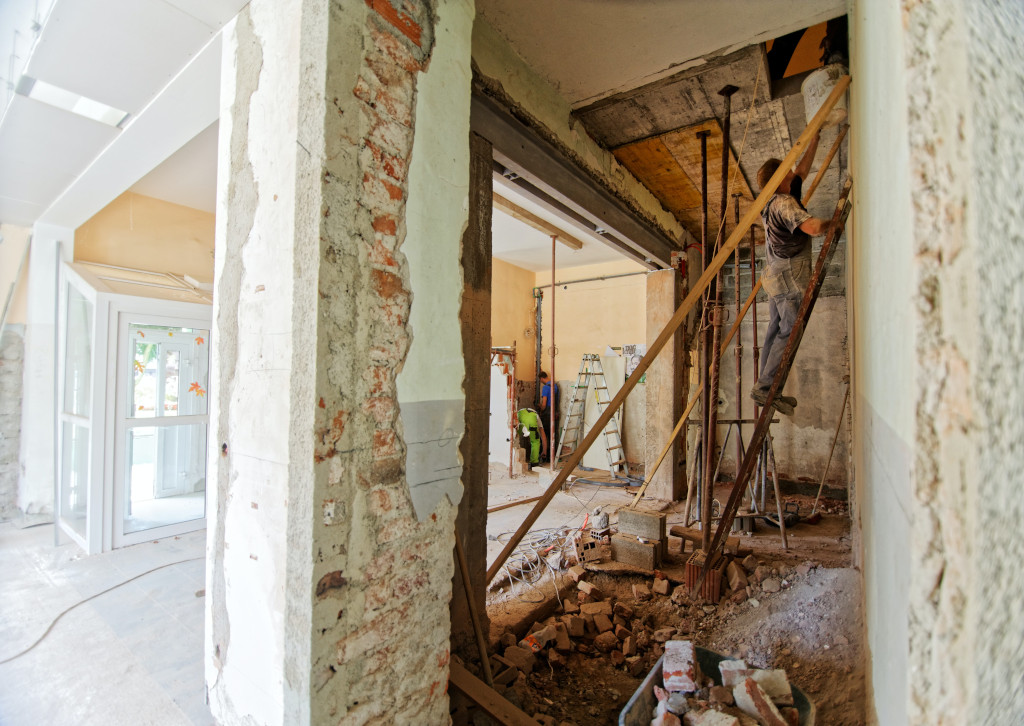
Carroll Estimating was established in 2019 to help and support main building contractors and developers better understand their tender and construction costs. Focusing on estimating services, the firm helps secure tenders and projects in a simple and effective way.
However, Carroll Estimating provides more than just an estimating service. The team combines over 40 years of experience and works in a collaborative partnership with clients and construction professionals alike to develop transparent and trusting relationships. With every tender, they provide affordable, professional, cost-effective, confidential and punctual estimating services from the smallest construction projects to large civil engineering projects across Ireland, the UK and Europe.
Delivering a competitive advantage to their clients is vital and additional estimated coded breakdowns are provided to ensure tenders are factually priced to the last nail. The team recognises the important role technology solutions play in providing accurate and speedy estimates, and the business has invested in sourcing the best estimating and procurement software to deliver results for their clients.
Technology playing a key role in company growth
Patrick Carroll, Director at Carroll Estimating, knows that the shortage of surveyors and estimators across Ireland means many major infrastructure and construction project professionals are time pressured when it comes to tendering and bidding.
“We work with main contractors in Ireland and we’re now expanding into the UK, but we really serve as an extension into their project team,” remarks Patrick. “We take the utmost pride in what we do because when our main contractors are successful, so are we.”
Ensuring that technology plays a vital role in their day-to-day operations is crucial for Patrick and the team, helping to deliver timely but accurate contributions on projects.
“We know that continually evolving and investing in the best technology solutions out there ensures we can provide the most accurate numbers in a timely manner to nurture our relationships. We thrive on repeat business and that comes with the quality of work we provide” reflects Patrick. The quality of work provided by Carroll Estimating is exemplified through their business growth.
Since starting out in 2018, Patrick has been able to grow the size and scale of projects the team work on through fostering their client and customer relationships as well as focusing on innovation. Patrick completed a Masters degree in construction informatics – a Building Information Modelling (BIM) course that provided him with solid knowledge around BIM theory and application as well as principles and practices of advanced construction technologies.
For Carroll Estimating, using BIM on projects and technology like a common data environment is essential for access to the most up-to-date project data and information. As an extension to the project team of the main contractors they serve, Carroll Estimating has experience using a variety of BIM platforms. In fact, Patrick insists this technology is used by all supply chain partners during construction tenders and bids to streamline communication between all stakeholders during the process.
Establishing better BIM practices and creating time savings
Leveraging BIM models for estimating is something Carroll Estimating prioritises on every project. They began a trial of Autodesk Takeoff, an Autodesk Construction Cloud solution, in early 2020 to explore options that would combine 2D and 3D quantification capabilities in one solution.
“We’ve been able to collaborate much more efficiently with our supply chain and main contractor partners as we’re all working from one single source of truth on our takeoffs, bids and tenders,” says Patrick. “We serve as an extension to the main contractor’s project teams, and can use the solution to communicate upfront with our design team colleagues on our needs later down the line.”
Using Autodesk Takeoff, Carroll Estimating can create competitive tenders by performing more accurate 2D takeoffs and generating automated quantities from 3D models. “Before using Autodesk Takeoff, we spent a lot more time on this process. As an example, on a particular project we needed to perform a takeoff for 400 doors, with over 20 door types, each type had a separate specification example some had timber or metal door frames. Previously, this activity may have taken a day to identify all of the doors on the model but now using Autodesk Takeoff, we can do this in less than a minute through the 3D model in the software,” says Patrick.
“The efficiencies for our team and our clients are what really stand out to us. Another example is the time it now takes to price structural floors – previously this may have taken half an hour and now we can do it in a matter of seconds.”
For Carroll Estimating, reducing the time spent on administrative tasks so the small team can concentrate on value-adding activities that support their clients’ needs is essential. Using Autodesk Takeoff has allowed them to do exactly this.
Patrick reflects: “Our contractors ask us to price jobs after doing measurements. When we’re working on big infrastructure or commercial projects, we could have up to 50-100 subcontractors working with our team. This means when we send out jobs for pricing, we would need to contact every single one four times as we generally get around four prices per trade. So already, we’re looking at potentially sending out pricing requests to 400 people!
“And when you add the number of email replies you may have to respond to, as well as chasing for quotes and so on, in a week you may have sent up to 1200 emails to complete that one task. Having everyone using one common data environment reduces these administrative tasks immensely – we use the clusters features in Autodesk Takeoff to break out floors, doors and windows to streamline this process and provide a visual representation.”
Staying competitive and growing their offering through technology
Not only does Carroll Estimating save time using Autodesk Takeoff’s features to generate accurate quantities needed for pricing, but the team is also able to verify and capture the most detailed quantities when it comes to bidding and tendering for future work.
As Carroll Estimating works with a number of model iterations on their projects, when drawings change, the team is alerted easily and quickly. They can then quickly verify how any changes affect their pricing using Autodesk Takeoff where previously these changes may have taken a number of days to update.
Collaborating with architects and designers on their projects in real-time in the model using Autodesk Takeoff means communication is more transparent and accurate. The project team can communicate clearly in the models on the needs for pricing and estimating work further down the line. This is vital as accuracy is key when it comes to bidding for work – the competition is fierce, and estimation needs to be spot on and competitive in the marketplace.
“For us as a team, working with more 3D models has opened up our marketplace. Previously, we were primarily doing jobs that had 2D drawings but now we’re able to work on more complex and bigger jobs as the solution improves our productivity,” says Patrick. “We’re also still able to takeoff more regardless of whether they are 2D or 3D models as we’re working from the same environment.” All of this means Carroll Estimating has the capacity to take on not only more work, but more varied work, ensuring that the team gets a diverse variety of projects to add to their portfolios.
Looking to the future, getting the most out of the features and functionality of Autodesk Takeoff is a priority for Carroll Estimating. The team continues to learn more about the capabilities as well as ensuring good BIM practices are established on projects.
Patrick remarks: “Good BIM practice not only saves time on projects but reduces the need for rework and the number of mistakes that can arise, as well as allowing remote collaboration. Our team isn’t required on site as much because we’re working in a more digital environment that is collaborative and transparent. Not only does this improve productivity but safety is also supported too.”
For Patrick, the value of working digitally using BIM is something every construction project should be doing and is the future direction the industry needs to take.
The post Using Technology to Slash the Time It Takes to Deliver Accurate Takeoffs With Carroll Estimating appeared first on Digital Builder.
Keep Projects on Track with the New Schedule Tool in Autodesk Build
Project delays in construction happen quite frequently, and typically result from poor planning. With such long time-tables, it’s difficult to plan for unforeseen schedule disruptions while managing the many moving parts of a project. Arguably the toughest part of a project manager’s job is managing the impact of those schedule disruptions across several teams working on the same project.
Looking closer, schedules are typically managed on a whiteboard in the trailer or by coordinators in the office. As a Project Manager or Schedule Coordinator, it’s often frustrating if you lack the tools to quickly relay the most current schedule information to your teams. From milestones, dependencies, and tasks, keeping teams up-to-date is crucial to avoid potential delays and costly rework. In fact, research from Dodge Data & Analytics shows that 66% of general contractors are carrying added costs from overtime shifts on at least three quarters of their projects due to schedule slippage, with 50% of them needing to extend the project end date.
Today, we are excited to announce the new Schedule Tool available in Autodesk Build. The Schedule Tool enables teams to collaborate, connect, and integrate with the most up-to-date schedule. Schedules uploaded from traditional CPM software can be imported to the Autodesk Build project, delivering real-time access to master schedule data in the field to ensure that everyone is on the same page at the same time. Let’s explore four capabilities in the new Schedule Tool that help you keep projects on track.
Key features of new Schedule Tool

1. Schedule surfacing
Upload schedule data from CPM software such as Primavera P6, ASTA PowerProject, or Microsoft Project into Autodesk Build. Teams can instantly access the project schedule and comment on specific activities to update teams or suggest changes back to HQ.
2. Filter by relevant items only
Schedules can be thousands of activities long and not all users need to see everything. Leverage the Schedule Tool’s search options to find exactly what you’re looking for, when you need it. Set filters to create custom views to display only relevant items. Look three weeks ahead or behind the current schedule, and view items on a Gantt chart.
3. Connect references to schedule
Teams can seamlessly link references—Submittals, RFIs, Sheets, Assets, and more—to the activity Item, providing the necessary context between the two.
4. Connecting schedule & cost
With the Schedule and Cost Management integration, teams can import schedule data into Cost Management to connect cost to time, as well as more accurately forecast cash flow. This is done by linking budget line items to schedule activities. Teams can then use built-in forecast distribution curves to visualize cost spending based on the timeline. And when all budget line items are forecasted, teams can access a project-level cash flow analysis for better planning, insight, and risk mitigation. This allows teams to achieve their project margins.
See more of the Schedule Tool in action
By creating a centralized schedule ecosystem for all project team members to refer to, comment on, and share out during the project lifecycle, the Schedule Tool in Autodesk Build connects projects, teams, and businesses and sets them up for success.
If you’re interested in the Schedule tool or Autodesk Build in general, request a product demo.
What customers are saying
“The Schedule Tool in Autodesk Build is easy to use and has reduced the amount of time I spend on distributing the schedule to our teams. Before Autodesk Build, I had to update the schedule, publish it as a PDF, and email the PDF to the entire team. Now, the process is automated. I upload my Microsoft project schedule into Autodesk Build, and it distributes a link to a web-based version of the schedule to the team, with notifications about the changes.” —Bryan Nuckolls, Project Manager at BOLDT
“One thing that’s cool about the Scheduling Tool in Autodesk Build is the ability to link different references together to understand how Issues or RFIs are impacting the schedule. This capability allows us to have more context into what items may affect the schedule and have more meaningful conversations with our subcontractors and owners for faster issue resolution.” –Brian Popis, VDC Engineer at Barton Malow
More Product Updates Across Autodesk Construction Cloud
This month, we announced over 35 new product updates across Autodesk Construction Cloud. Learn more about all of our product releases in our blog. For the latest updates specific to Autodesk Build, you can check out this blog post.
The post Keep Projects on Track with the New Schedule Tool in Autodesk Build appeared first on Digital Builder.
You Have Data — But Do You Have Construction Insights?

When it comes to data in construction, there’s good news and bad news. The good news is, construction professionals recognize the value of data and are collecting a tremendous amount of information. In fact, research from FMI Corp shows 2.5 quintillion bytes of data are produced daily.
The bad news? The vast majority of that data — 95.5% according to FMI — goes unused in the E&C industry. And for the data that does get used, “bad” data may contribute to over $1.8 trillion in global construction industry costs. That’s a startling figure to come out of the recently released report, Harnessing the Data Advantage in Construction, made in partnership between Autodesk and FMI.
So while data can be powerful when generating insights, failing to harness it properly can do more harm than good. For a single contractor doing $1 billion in annual revenue, our research shows that bad data could cost them upwards of $165 million yearly. With so much on the line, you can see how good insights, based on good data, are a practical necessity.
Issues like wasted time and diminished productivity often arise. In fact, research shows that 13% of construction professionals’ working hours are devoted to looking for project data and information.
This tells us that while we have a lot of data, we don’t have much insight.
But don’t worry, there’s hope. If your construction firm is data-rich but insight-poor, know that there are a number of actions you can take to effectively leverage all the information you have.
Let’s explore the data issues that construction pros are facing and how to address them.
Data Challenges in Construction
Data overload and difficulty with connecting data points are two of the biggest challenges we face today.
A good question to ask yourself is, “What’s so bad about ‘bad’ data?” The problem is that when it gets used, it harms insights, enables poor decision-making, and opens you up to unnecessary risk. A downstream consequence of poor decision-making is the often understated erosion of trust in the same data you need. This directly impacts your team’s ability to make decisions confidently with data in the future.
Our research shows that data has actually doubled in the last three years alone, yet only about 55% of organizations have a formal data strategy in place to make good use of all that data. For the other 45%, as you can tell, making confident decisions with bad data is not only risky, but costly.
Travis Voss, Leader of Innovative Technology at Helm-Mechanical shares, “The two skills that will be paramount in the future are understanding how to connect and relate data from disparate sources.” In other words, to get to those high-value insights, how do we connect disconnected data?
More expert insight comes from an Autodesk University session in 2020. Manu Venugopal, Group Product Manager at Autodesk, says that most of what’s collected is stored in data silos, making it even more difficult to derive insights.
It’s no surprise then, that Forrester found that while 74% of firms want to be more “data-driven,” only 29% are successful at turning data into insights and actions.
“Unless we break down the silos, we can’t fully leverage all this data and get insights from it,” said Venugopal.
Recognizing the Difference Between Data, Analytics, and Insights
There are three key components to effective data utilization: data, analytics, and insights. Overcoming the challenges mentioned above starts with understanding these three things, and making sure that everyone in the organization shares the same definition of these concepts.
Only then can you effectively determine the tools, people, and processes you need to collect, analyze, and draw conclusions from data.
Let’s look at these components individually in the context of the construction industry.
Data refers to quantitative and qualitative measures collected in raw form. In construction, this could be things like the number of defects, safety incident rates, time spent dealing with change orders, observations on the jobsite, etc.
Data collection specialists and data engineers are usually the types of professionals in charge of handling these measures. People in these roles clean, aggregate, and enter the information to be analyzed.
Analytics, on the other hand, involves processes and technologies that help translate the raw data into formats that people can understand — typically reports and dashboards. Effective data analytics requires a robust construction platform as well as data analysts who can help with inspecting and transforming data into the best format.
Then we have insights, which are the meaningful realizations and actions that the organization implements based on data and analytics. While there are official roles designed for deriving insights (one example is the role of insight analysts), extracting insights from data and analytics is something that many people in the organization can do.
For instance, field managers and general contractors who regularly monitor metrics like incident rates, rework costs, or waste can use all that information to come up with processes that improve profits and productivity on the jobsite.
Key Pillars to Move from Data to Insights
Now that we’ve covered the fundamentals of data, analytics, and insights, let’s discuss how construction firms can put all of the above to good use. Here are the pillars of effective data management and analysis.
Digitization. With so many metrics and data points to be collected and analyzed, it’s simply impossible to do things manually. That’s why the first pillar of moving from data to insights is digitization.
Do note that going digital isn’t simply about replacing pen and paper with technology; it’s about reimagining your processes to make data collection and sharing more efficient.
As Venugopal put it, digitization “isn’t just about moving off of paper although that’s an important first step. It’s about enhancing the way information is shared, often in ways that weren’t even possible before and leveraging connected devices in the office and field to expand access to project information and help everyone make faster and better decisions.”
Workforce upskilling. With so much riding on the quality of your data, having a workforce with data skills may give you a healthy competitive edge.
Digital transformation is inevitable in the construction industry worldwide. How and when you choose to embrace it will affect your team’s ability to make great data-driven decisions when they count most.
Workflow integration.You may be using digital tools, but if your systems and workflows aren’t integrated, becoming more data-centric will be an uphill battle.
So, strive to run your workflows on a tightly integrated system. Connected construction workflows open up several benefits, including higher levels of efficiency, reduced risk, and better collaboration.
As such, your construction platform should enable the smooth data transfer from one project phase to the next and enable all stakeholders to be in sync.
Open and connected data access. See to it that you’re using an open platform that allows you to quickly find, access, and retrieve data. This openness is critical, particularly in a fast-paced environment where you need to get your hands on the right information ASAP.
Closely related to this is having connected datasets. Your workflows should be linked so that any updates or changes to your data are automatically synced across your systems. This way, you’re able to access the right information at any given time.
Flexible visualizations. Raw data by itself is hardly useful. Your team should be able to view data in a user-friendly format — hence the need for visuals like graphs, tables, and reports.
The manner in which data is presented can make all the difference, so get yourself a system that supports user-friendly and flexible visualizations. There are data platforms that offer templates or pre-built dashboards for things like resolution workflows, RFI management, etc.
The best-in-class solutions come with configurable visualizations that let you tailor your reports to fit your needs. This flexibility is essential because there are many cases when you need to slice and dice the information to fit a specific project or situation.
Streamlining intelligence. Data-backed insights are the bedrock of good business decisions, so you want to optimize your data analysis for success. While team members can certainly put their heads together to gather intel, it doesn’t hurt to use technology to automate your data efforts.
Adopt construction technology that uses AI and machine learning to provide real-time and automatic insights from the data you’re capturing. The right solution, said Venugopal, can help “flag any riffs, improve the accuracy of your workflows as well as help standardize and structure the data” — ultimately streamlining your operations and helping you deliver projects quickly, and in the most cost-effective way possible.
Data and insights go hand-in-hand in construction
The future of construction will be a lot more insightful. In order to thrive, your firm needs people, processes, and tools that can help you unlock the valuable insights within your construction data.
To do that, start by making sure that your organization understands the ins and outs of data, analytics, and insights. It’s important to establish the key pillars discussed above so you can have a solid foundation on which to build and implement your initiatives.
If you’d like to learn more about how to turn data into insights, learn more about Autodesk Construction Cloud to find out how our platform keeps your workflows, teams, and data connected at every phase of construction. Additionally, if you’d like to learn why a formal data strategy may be the game changer you’ve been needing, download Harnessing the Data Advantage in Construction, a report made in partnership between Autodesk and FMI.
The post You Have Data — But Do You Have Construction Insights? appeared first on Digital Builder.
The Pros and Cons of Roofing Replacement Vs. Repair
What exactly is roofing replacement? Roofing replacement involves replacing the old felt or roofing paper and metal or moisture barriers and placing new ones in their place. It may also include fixing or replacing any damage revealed when removing the previous roofing materials or the existing roof. The entire process can be rather complicated, and it is only through proper supervision that this work should be carried out to ensure that it is done correctly.
If you wonder whether roofing replacement is worth doing, the first thing you need to do is find out the extent of the damage. Many people would instead choose to repair the roof damages rather than replacing them with a new one. However, experts will suggest that it is always better to repair the roof damage as it is cheaper and a good option for long-term solutions. Some pros and cons from that can help you understand whether it is worth doing or not.
One of the advantages of roofing replacement is that it costs less than repairing the roof by replacing it with a new one. Another advantage of doing it is that it will not only fix the present problem but will also prevent any future problem. Also, the roofing replacement will increase the property’s value making it a great investment. Even though you will have to spend some extra money in the process, the cost of replacing it with a new second layer is actually much lower than repairing it.
Apart from the advantages there are also some disadvantages of roofing replacement. It is expensive especially for homeowners who cannot afford to have it done. Moreover, repairing your roofing will require you to spend some time on the roof repairing it. The repairs may also require some effort and you may have to wait for some time before your roofing starts to look good. It may also take more time to complete the repairs than having a new shingle roof installed.
When it comes to the pros and cons of roofing replacement vs. repair, the pros are definitely better than the cons. Roofers who do the work do it very professionally, which means that they do not provide you with a cheap and substandard work that sometimes comes with amateurish work. On the other hand, homeowners do not have to worry about finding good roofers as there are lots of professionals in the industry that make it their profession to provide you with a perfect and high quality work. If you compare both of them then you will definitely find out that the pros far outweigh the cons.
However, even though the pros and cons are in favour of repairing the roof rather than having a roof replacement may not be in favour of it. One of the main reasons is that repairing your roof costs you more money. In fact, if the damages are severe and you need to get the repairs done right away, then you will definitely have to shell out a lot of money for it. Having a roof replacement may not be the best idea when you are experiencing severe damages because this may not only cause you more damage, but also compromise your home’s structure if it is made from wood. If you are not sure whether to get a repair or not, you can always call a roofing specialist to get a better idea on what you should be doing.
Even though the pros and cons may point towards having a roofing replacement or repairing the roof, you can always replace a damaged section of the roof yourself. This is usually referred to as patching. There are many roofing contractors who can provide you with a patch kit that you can use to replace a section of the roof on your own. When you choose to have a patching job done, it is recommended that you hire a roofing contractor to ensure that the job is done right. Although many people prefer to hire professional contractors because they know exactly what they are doing, some homeowners would rather remove the damaged part and do the job themselves. However, you have to keep in mind that removing a section of the roofing may also void your homeowner’s insurance policy, so make sure that you are covered.
Roofing replacement or repairing your roof yourself is usually best if the damage caused by the strong winds is extensive. This type of damage would most likely require a total replacement. However, if the damage seems like a simple repair job, then you should think again. Replacing your roof yourself is always a good idea, but if you feel that you need professional help, then it would be better to hire a roofing contractor to ensure that the job is properly done.
Akela Group moves into England with new Leeds hub
Scottish civils contractor Akela Group is moving into the English market with the opening of a new division in Leeds.
The new North of England hub will lead expansion plans outside of Akela’s traditional Scottish base.
The firm expects its business to grow by 10% over the next two years as a result of the move.

The new Leeds team will be led by Construction Manager, Martin Leahy, who brings over 15 years industry experience having previously worked with the Robertson Group and Laing O’Rourke.
Group company Akela Ground Engineering has secured its first contract at Knaresborough in the North of Yorkshire and is currently tendering for a variety of new housing and commercial build contracts throughout the county.
Across Scotland the Akela Group currently employs 300 staff providing civil engineering, construction, piling and training services.

Mark Markey, Akela Group Managing Director, said: “We are delighted to see our long term ambition to expand and grow the company in front of a UK audience come to fruition. We are seeing increased levels of demand for the wide range of ground engineering and civil engineering services, particularly in the North of England and we are well placed to meet that growing demand.
“The opening of the Leeds hub presents an excellent growth opportunity for the Akela Group and it will bring an abundance of employment opportunities and economic benefits to the region and beyond.”
Leahy said: “It’s an exciting time for the Akela Group and there is a huge opportunity to grow the business in the North and I am delighted to be leading the team at the new Leeds hub.
“I am passionate about collaboration and delivering insightful solutions for clients and l look forward to working on a wide range of projects as we realise the growth ambitions in the North of England.”


35+ New Product Updates for Autodesk Construction Cloud
The Latest Across Autodesk Construction Cloud Unified Platform, Autodesk Build, Autodesk BIM Collaborate, Autodesk Takeoff, BuildingConnected, BIM 360, and Assemble
We spend a lot of time listening to customers so we can build the products and incorporating the features you need most. Our team has been hard at work, and thanks to your feedback on the user experience, I’m excited to share over 35 new feature releases and enhancements across Autodesk Construction Cloud products.
From ensuring project schedule detail is always visible no matter where you are, to faster resolution of design discrepancies with deeper issue tracking, the latest product updates within Autodesk Construction Cloud can be found below.
Jump to releases by product:
-
- Autodesk Construction Cloud Unified Platform
- Autodesk Build
- Autodesk BIM Collaborate
- Autodesk Takeoff
- BuildingConnected
- BuildingConnected Pro
- Bid Board Pro
- TradeTapp
- BIM 360
- Assemble
Autodesk Construction Cloud Unified Platform

* = features on both Autodesk Construction Cloud Unified Platform & BIM 360
API | App Gallery
The App Gallery allows Account Admins to easily connect Autodesk Construction Cloud platform products with third-party apps such as augmented reality tools, jobsite cameras or scheduling applications. The App Gallery allows users to explore and discover a range of integration solutions that leverage the Forge open platform for seamless data flow.
Administration | Limit Project & Template Creation to Account Admins
Autodesk Construction Cloud Unified Platform users can now limit the creation of new projects and new project templates to only Account Admins. This restriction creates more control, improves standardization, and ensures the unnecessary creation of duplicate projects or project templates.
Administration | Product Display List in Project Admin & Members Pages
Project Admins will now only see the products they have purchased as options to assign to members. This will avoid potential confusion of which products or licenses are available to use. Additionally, Account Admins will have the option from this screen to purchase or add additional products.
Administration | UI Updates to Project List Page
Users can now see additional links to other Autodesk Construction Cloud products in the top of the project list page. The addition of these links will help teams save time with the ability to easily access other Autodesk Construction Cloud products like BuildingConnected and TradeTapp.
Document Management | Search Reviews and Transmittals by Name
You now have access to a new search bar at the top of the Reviews and Transmittals pages. By inputting a keyword in the search bar, users will be able to search through all Reviews and Transmittals to quickly find what they’re looking for.
Document Management | Hypermodel Viewing and Alignment
Users will now get a better understanding, and visualization, of their 2D drawings and 3D Models with hypermodel viewing and alignment. Users can choose 2D drawings to position on top of a sectioned 3D model to align and seamlessly navigate between.
Document Management | Holding Area Update
Previously, files in the Holding Area were split into batches based on upload group with a time/date stamp. The Holding Area will now show all files in a single list and will be sortable by columns so Admins can easily review, edit, and approve.
Document Management | Custom Attributes Enhancements *
You now have better document control with custom attribute enhancements. For example, Custom Attributes with text fields now have character type and character limit constraints. In addition, Admins have the ability to edit custom attributes that already have data associated with them.
Dashboards | Additional Partner Cards
Both Autodesk Construction Cloud Unified Platform and BIM 360 users will now see new partner cards for Google, Airtable, Join.BUILG , Stevenson Systems, Embneusys, Field Control Analytics, Lambertsson, OpticVyu, ProgressCenter, ProNovos, Quickbase, Safe Site Check In, SignOnSite, StructShare, TopBuilder, and WakeCap.
Autodesk Build
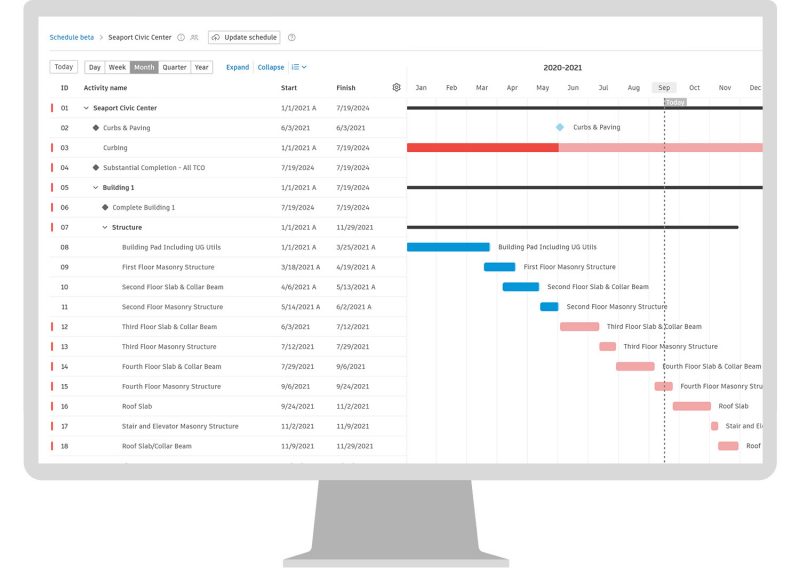
** = features in both Autodesk Build & BIM 360
*** = features in Autodesk Build, Autodesk BIM Collaborate & BIM 360
Schedule Tool
Autodesk Build’s Schedule Tool is now available for all Autodesk Build users! Schedules uploaded from Primavera P6, Microsoft Project, and ASTA Powerproject can be imported to a Build project and displayed in a Gantt chart or calendar view.
Create custom views that display desired schedule items with the filter function, allowing users to look three weeks ahead or behind the current schedule. Share the schedule with field teams so they can comment on specific activities and link references to each activity item. References include photos, files, sheets, assets, and issues. Users can also integrate Schedule with Cost in Autodesk Build to improve budgeting and planning for schedule-related costs.
Get all the details on the new Schedule Tool in this blog post [coming soon].
Data Connector | Forms Data & Power BI Template
Coming early October. Autodesk Build users can now extract Forms data using the Data Connector as well as leverage a new Power BI Template. This will help improve visibility into how teams are using forms, an overview of the status of forms, and highlight any issues that need to be addressed.
Data Connector | Updates to Document Management & Assets Power BI Templates **
There is now a new Document Management Power BI Template that includes formats for both csv and compatibility with the Power BI Connector tool. Additionally, there is a new Asset Power BI Template that is compatible with the Power BI Connector tool. These templates help teams start to create custom dashboards that align more to their company KPI’s while using easy out-of-the-box options.
Templates | Adding Form Templates from Account Library
Account Admins will now see the ability to add a form template directly to a project template. This can be created within the account level library. This expands on the standardization capabilities ensuring that teams are always inputting the right data via the most up-to-date templates.
Meetings | Microsoft Teams Integration ***
Autodesk Build and BIM Collaborate users will now be able to add a Microsoft Teams meeting link directly from the meeting. This helps to enable more collaboration between project teams as users can now choose between Zoom and a Microsoft Teams collaboration toolsets.
RFIs | Email mechanism for project team members
Coming early October. Project team members can now reply to RFIs directly from the email notification, without logging into the platform. If a team member has a ball-in-court, their response will be noted as the official response and the RFI will automatically move to the next step in the process. This increases collaboration, streamlines the process, and helps improve the response time for RFIs.
RFIs | Enhanced References
Autodesk Build users can add additional references including submittals, forms, assets, and schedule items. When referencing RFIs in other tools, such as Issues, users will be able to search and filter across all RFIs, making it easy to connect workflows within Build.
RFIs | View and edit custom fields on mobile
Autodesk Build users can now view and edit custom fields, within RFIs, directly from their mobile devices.
RFIs | Quick List Action / Three dot menu
Autodesk Build users can now perform quick RFI actions from the RFI menu within the RFI log. These actions include: duplicate RFI, sending a reminder email to the RFI ball-in-court, and exporting the RFI.
Submittals | View linked markups on mobile
Autodesk Build users can now view linked submittals directly from markups on their iOS and Android advice. This ensures that all team members, especially those in the field, have access to important project documents.
Cost Management | Connection to Locations**
Autodesk Build and BIM 360 Cost Management users can now connect a location to budget and change order items. This feature allows teams to see how much money is allocated to specific areas in the building, and have a location-based view of changes. This provides a powerful way to track patterns to mitigate risk and potential cost overruns.
Cost Management | Cost Payment Applications Custom Approval Workflows**
Autodesk Build and BIM 360 Cost Management users can now utilize the decision-based workflow engine to create custom workflows to automate the internal review and approval process of cost payment applications.
Forms | Forms Tab UI Revamp on Mobile
Coming soon. The Forms tab UI will be revamped to offer a more convenient experience to mobile users. With this improvement, finding and quickly editing form drafts becomes easier for the field team. The update includes a new “At a glance” view and searching and filtering options.
Photos | Locations
Users will have the ability to add a location to a photo. Linking jobsite photos to predefined project locations will help teams further standardize the way they collect and organize their data.
Learn more about this month’s product releases specific to Autodesk Build in this blog post.
Autodesk BIM Collaborate
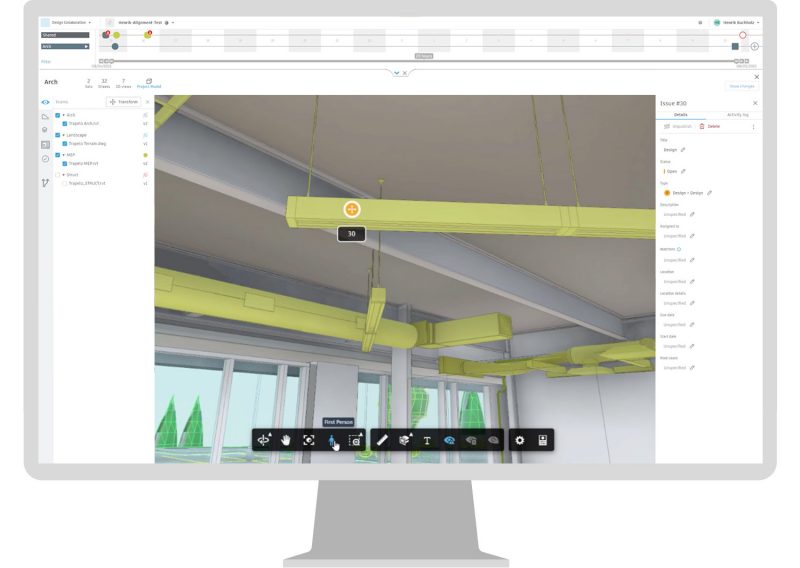
Design Collaboration | Design Issues
Design issues in Autodesk BIM Collaborate help teams communicate and resolve design discrepancies in 2D and 3D by detailing the who, what, and where—all in the same environment where design packages are created and reviewed.
Issues in design collaboration use the same communication solution as is used in coordination workflows, field workflows, and the Revit add-in, making it easy to assign and resolve issues in whichever tool is necessary to get the job done.
Upfront issue communications create higher quality designs and have a cascading effect on downstream workflows, making the job of the BIM manager and the project manager all that much easier.
Get all the in-depth details on the new Design Issues feature in this blog post [coming soon].
Design Collaboration | Team Content Folders
Each team on a project can now define which folders they’d like to see in their team space. The team content folders will only show the selected sub-folders for quicker access to the most relevant models, sheets, and pdfs. Permissions can be assigned for each team folder as well as creating an exclusive coordination space for that team’s models is quick and easy. With fewer files to load, teams gain speed and efficiency in the package creation process
Autodesk Takeoff
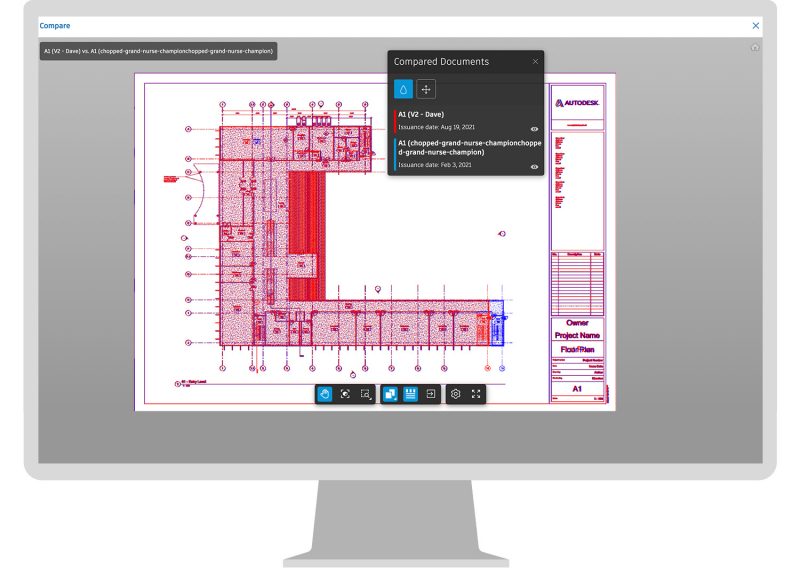
File Compare
Users can now compare PDF versions directly in Autodesk Takeoff without the need to run the compare in Autodesk Docs. This helps streamline change management and creates a smoother takeoff process. Users can either compare files side by side or use the overlay option.
BuildingConnected
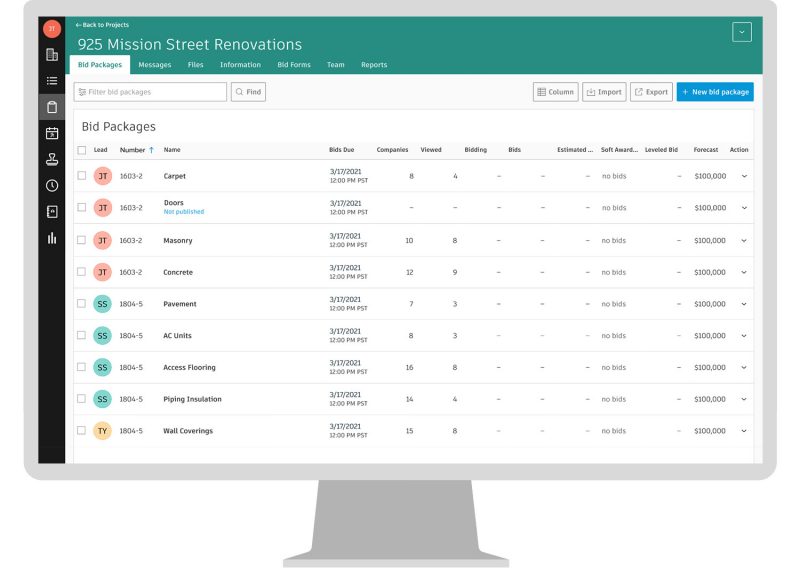
BuildingConnected Pro
Updated Look and Feel
Coming soon. Users can now experience an updated look and feel with new typography and colors in BuildingConnected Pro. Product functionality remains the same.
New Proposals API Endpoint
For users that use BuildingConnected Pro’s API, there is a new API endpoint available for proposals submitted. Information such as line item descriptions, unit costs, total cost, and revisions are available to use.
Bid Board Pro
Updated Look and Feel
Coming soon. Users can now experience an updated look and feel with new typography and colors in Bid Board Pro. Product functionality remains the same.
TradeTapp
Expanded Auto-Renewals
Users can now configure vendor auto-renewals to send based on qualification status expiration, financial statement expiration, and/or certificate of insurance expiration.
BIM 360
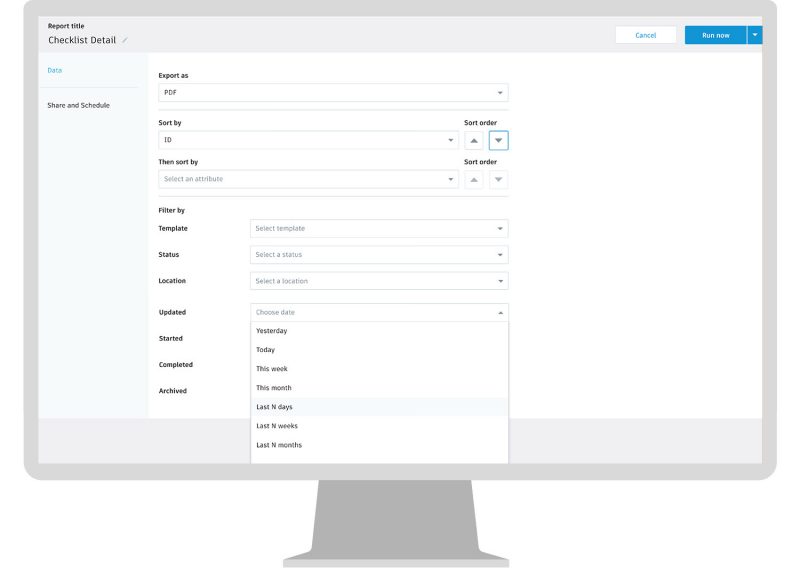
Reports | Display Asset Detail in Checklist Report
Coming early October. The Checklist Detail Report in BIM 360 will now include details about assets that are referenced back to a checklist. This will give users access to any relevant asset data so they can save time by addressing issues quickly during inspections.
Reports | Checklist Report Filter Enhancement
BIM 360 users will now see a new “Updated” filter option for the Checklist Detail and Checklist Summary reports. This allows users to select a timeframe for showing checklists that have been updated within a specified time range. This also gives users the ability to create more relevant reports with more specific data.
Checklists | Offline Checklist Creation
Coming early October. BIM 360 mobile users will be able to create a checklist even when their phone doesn’t have an internet connection. Thanks to this feature, even if field teams need to work on sites with no internet connection, they can still start filling out checklists which will sync up to the cloud once they are back online.
Checklists | Filter by Creation Date
BIM 360 users can now filter checklists based on their creation date by using the new “Created On” filter. Thanks to this new filter, project members who need to review checklists created within a certain time frame, can quickly find what they are looking for.
Checklists | Attach Document from Local Drive
Coming soon. Similar to RFIs and Issues, BIM 360 users will be able to attach a document from their local drive to a checklist as well. The document will be stored as an attachment to the checklist only, it won’t show up among the project files.
Submittals | Reporting and Submittal Enhancements
All BIM 360 users will now be able to create reports and filter submittal items by sub-status and due date, increasing transparency and connectivity. Users will also be able to export search results and leverage the new XLSX export format within the submittals overview tab.
Assemble
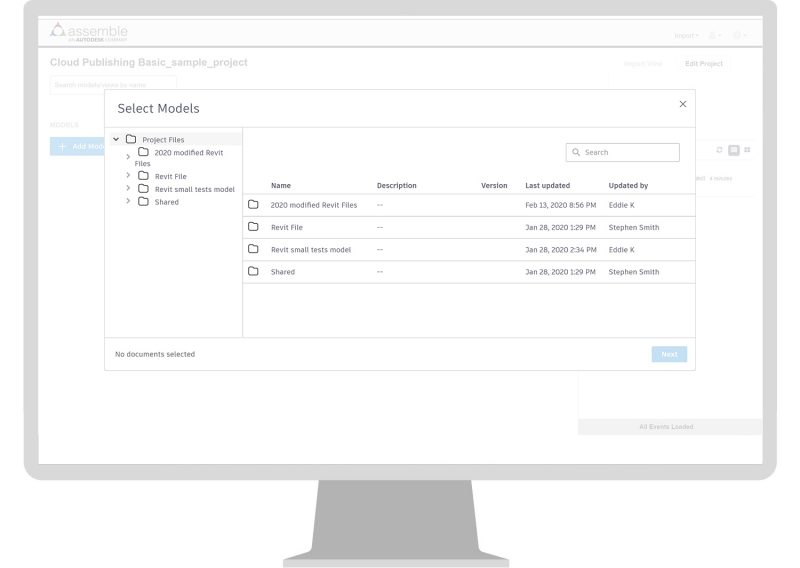
Model Publishing Enhancements
Assemble users can now publish Revit models directly from Autodesk Docs and BIM 360 Docs to Assemble without the need of Revit add-in. This greatly reduces duplication of efforts by leveraging the common data environment. It also helps ensure everyone is working from the latest project documents.
Stay in the Know for More Autodesk Construction Cloud Product Updates

The post 35+ New Product Updates for Autodesk Construction Cloud appeared first on Digital Builder.
Autodesk Build Gets 20+ Product Updates, Features, and Enhancements
Learn about the latest releases for Autodesk Build
When we launched Autodesk Build earlier this year, we set out to give construction teams a powerful set of tools for seamless collaboration between field and office. Autodesk Build is now a centerpiece for managers on thousands of projects worldwide.
In the last few months, our team has been working hard to release over 20 new updates, features, and enhancements—all geared towards helping you better connect your teams, data and processes. So, whether you’re looking to ensure schedule detail is always visible no matter where you are, or need to make your RFI process a much smoother one, check out the latest Autodesk Build releases below.
Jump to details by type:
- Highlighted Releases
- Schedule Tool
- Document Management Releases
- Custom Attributes enhancements *
- Holding Area update
- Hypermodel viewing and alignment
- Search Reviews and Transmittals by name
- Cost Releases
- Cost Management
- Connection to locations **
- Cost payment applications custom approval workflows **
- Cost Management
- Project Management Releases
- Meetings | Microsoft Teams integration ***
- RFIs
- Email mechanism for project team members
- Enhanced references ***
- View and edit custom fields on mobile ***
- Quick List action / Three dot menu
- Submittals | View linked markups on mobile
- Field Collaboration Releases
- Photos | Locations **
- Forms | Forms tab UI revamp on mobile
- Templates | Adding Form templates from Account Library
- Data and Intelligence Releases
- Dashboards | Additional Partner cards
- Data Connector
- Forms data & Power BI template
- Updates to Document Management and Assets Power BI templates *
- Admin Releases
- Administration
- Limit project and template creation to Account Admins
- Product Display list in project Admin and Member pages
- UI updates to Project List page
- API | App Gallery
- Administration
* = features on both Autodesk Construction Cloud unified platform and BIM 360
** = features in both Autodesk Build and BIM 360
*** = features in Autodesk Build, Autodesk BIM Collaborate and BIM 360
Highlighted Releases
Schedule Tool
Autodesk Build’s Schedule Tool is now available for all Autodesk Build users! Schedules uploaded from Primavera P6, Microsoft Project, and ASTA Powerproject can be imported to a Build project and displayed in a Gantt chart or calendar view.
Create custom views that display desired schedule items with the filter function, allowing users to look three weeks ahead or behind the current schedule. Share the schedule with field teams so they can comment on specific activities and link references to each activity item. References include photos, files, sheets, assets, and issues. Users can also integrate Schedule with Cost in Autodesk Build to improve budgeting and planning for schedule-related costs.
Get all the details on the new Schedule Tool in this blog post [coming soon].
Document Management Releases
Document Management | Custom Attributes Enhancements *
You now have better document control with custom attribute enhancements. For example, Custom Attributes with text fields now have character type and character limit constraints. In addition, Admins have the ability to edit custom attributes that already have data associated with them.
Document Management | Holding Area update
Previously, files in the Holding Area were split into batches based on upload group with a time/date stamp. The Holding Area will now show all files in a single list and will be sortable by columns so Admins can easily review, edit, and approve.
Document Management | Hypermodel Viewing and Alignment
Users will now get a better understanding, and visualization, of their 2D drawings and 3D Models with hypermodel viewing and alignment. Users can choose 2D drawings to position on top of a sectioned 3D model to align and seamlessly navigate between.
Document Management | Search Review by Name
You now have access to a new search bar at the top of the Reviews page. By inputting a keyword in the search bar, users will be able to search through all Review Names to quickly find the Review they’re looking for.
Cost Releases
Cost Management | Connection to Locations **
Autodesk Build and BIM 360 Cost Management users can now connect a location to budget and change order items. This feature allows teams to see how much money is allocated to specific areas in the building, and have a location-based view of changes. This provides a powerful way to track patterns to mitigate risk and potential cost overruns.
Cost Management | Cost Payment Applications Custom Approval Workflows **
Autodesk Build and BIM 360 Cost Management users can now utilize the decision-based workflow engine to create custom workflows to automate the internal review and approval process of cost payment applications.
Project Management Releases
Meetings | Microsoft Teams Integration ***
Autodesk Build and BIM Collaborate users will now be able to add a Microsoft Teams meeting link directly from the meeting. This helps to enable more collaboration between project teams as users can now choose between Zoom and a Microsoft Teams collaboration toolsets.
RFIs | Email mechanism for project team members
Coming early October. Project team members can now reply to RFIs directly from the email notification, without logging into the platform. If a team member has a ball-in-court, their response will be noted as the official response and the RFI will automatically move to the next step in the process. This increases collaboration, streamlines the process, and helps improve the response time for RFIs.
RFIs | Enhanced References
Autodesk Build users can add additional references including submittals, forms, assets, and schedule items. When referencing RFIs in other tools, such as Issues, users will be able to search and filter across all RFIs, making it easy to connect workflows within Build.
RFIs | Quick List Action / Three dot menu
Autodesk Build users can now perform quick RFI actions from the RFI menu within the RFI log. These actions include: duplicate RFI, sending a reminder email to the RFI ball-in-court, and exporting the RFI.
RFIs | View and edit custom fields on mobile
Autodesk Build users can now view and edit custom fields, within RFIs, directly from their mobile devices.
Submittals | View linked markups on mobile
Autodesk Build users can now view linked submittals directly from markups on their iOS and Android advice. This ensures that all team members, especially those in the field, have access to important project documents.
Field Collaboration Releases
Photos | Locations
Users will have the ability to add a location to a photo. Linking jobsite photos to predefined project locations will help teams further standardize the way they collect and organize their data.
Forms | Forms Tab UI revamp on mobile
Coming soon. The Forms tab UI will be revamped to offer a more convenient experience to mobile users. With this improvement, finding and quickly editing form drafts becomes easier for the field team. The update includes a new “At a glance” view and searching and filtering options.
Templates | Adding Form Templates from Account Library
Account Admins will now see the ability to add a form template directly to a project template. This can be created within the account level library. This expands on the standardization capabilities ensuring that teams are always inputting the right data via the most up-to-date templates.
Data & Intelligence Releases
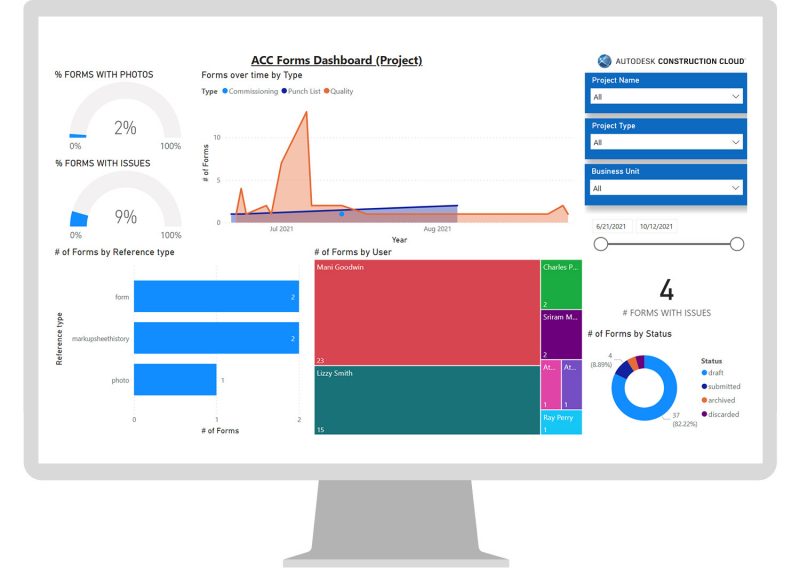
Dashboards | Additional Partner Cards
Both Autodesk Construction Cloud Unified Platform and BIM 360 users will now see new partner cards for Google, Airtable, Join.BUILG , Stevenson Systems, Embneusys, Field Control Analytics, Lambertsson, OpticVyu, ProgressCenter, ProNovos, Quickbase, Safe Site Check In, SignOnSite, StructShare, TopBuilder, and WakeCap.
Data Connector | Forms Data & Power BI Template
Coming early October. Autodesk Build users can now extract Forms data using the Data Connector as well as leverage a new Power BI Template. This will help improve visibility into how teams are using forms, an overview of the status of forms, and highlight any issues that need to be addressed.
Data Connector | Updates to Document Management & Assets Power BI Templates **
There is now a new Document Management Power BI Template that includes formats for both csv and compatibility with the Power BI Connector tool. Additionally, there is a new Asset Power BI Template that is compatible with the Power BI Connector tool. These templates help teams start to create custom dashboards that align more to their company KPI’s while using easy out-of-the-box options.
Admin Releases
Administration | Limit Project & Template Creation to Account Admins
Autodesk Construction Cloud Unified Platform users can now limit the creation of new projects and new project templates to only Account Admins. This restriction creates more control, improves standardization, and ensures the unnecessary creation of duplicate projects or project templates.
Administration | Product Display List in Project Admin & Members Pages
Project Admins will now only see the products they have purchased as options to assign to members. This will avoid potential confusion of which products or licenses are available to use. Additionally, Account Admins will have the option from this screen to purchase or add additional products.
Administration | UI Updates to Project List Page
Users can now see additional links to other Autodesk Construction Cloud products in the top of the project list page. The addition of these links will help teams save time with the ability to easily access other Autodesk Construction Cloud products like BuildingConnected and TradeTapp.
API | App Gallery
The App Gallery allows Account Admins to easily connect Autodesk Construction Cloud platform products with third-party apps such as augmented reality tools, jobsite cameras or scheduling applications. The App Gallery allows users to explore and discover a range of integration solutions that leverage the Forge open platform for seamless data flow.
To see the full list of our latest updates across all Autodesk Construction Cloud, please check out this blog post.
Get the newsletter and stay up to date on the latest features and product announcements

The post Autodesk Build Gets 20+ Product Updates, Features, and Enhancements appeared first on Digital Builder.
Did you miss our previous article…
https://www.arizonasolarsociety.com/?p=585
6 Leaders in Construction Share Priority Data Skills to Plan for Now
Picture this. Project setbacks are no longer something to dread, instead, you’re able to navigate them with ease. Your project is on track and your entire workforce, from jobsite managers to executives in the office, are seamlessly sharing real-time data—and making great decisions because of it. Every phase of construction is on time and on budget. Sounds like a dream, right? You might be surprised to learn that this dreamscape is closer to reality than you think.
So, what holds so many construction firms back from achieving this possibility? Harnessing the Data Advantage in Construction, a global industry report made in partnership between Autodesk and FMI, uncovers some answers to this pertinent question.
According to our research, over $1.8 trillion in global construction waste may be caused due to bad data. The root of this problem is largely associated with deficiencies in the quality of data you make decisions from. In turn, this issue begs some important questions directly related to how skilled your workforce is in leveraging the plethora of data points.
As a leader or manager, ask yourself:
- What kind of skills are needed to make sure my teams keep up with industry tech?
- Should I be investing in my teams’ data and tech skills? What does that look like?
- What roles should I expect to fill as construction becomes more data-driven?
To help answer these questions, we spoke with several respected technology leaders in construction. They shared their thoughts on the importance of workforce upskilling and tips for embracing the data-driven world of construction. What we found was a range of ideas for getting more value from your data, how to properly govern data, and suggestions for fostering a data-first culture. Read on for their insights.
Data skills with high value
The volume of construction data has doubled in the last three years according to our research in the data strategy report mentioned above. We asked, “What data management or analytical skills do you think will be most important in the future of the construction industry?”
Understanding the value of data in decision-making
 “In general, every person should understand the value of data and data-driven decision-making. This might include how to think about what data is important for evaluating a particular business process or problem area, effective ways to visualize data, and even applying basic statistics concepts like correlations and standard deviations.” —Warren Kudman, CIO, Turner Construction Company
“In general, every person should understand the value of data and data-driven decision-making. This might include how to think about what data is important for evaluating a particular business process or problem area, effective ways to visualize data, and even applying basic statistics concepts like correlations and standard deviations.” —Warren Kudman, CIO, Turner Construction Company
Making data trustworthy and easy to access
 “Robust data collections and a single source of truth are critical for a successful project. The data needs to be timely and accurate. Users should be able to trust the data. In addition to this, the data entries need to be automated. People should not have to enter the same data in multiple systems.” —Hrishi Maha, Leader Data Analytics and Software Development, DPR Construction
“Robust data collections and a single source of truth are critical for a successful project. The data needs to be timely and accurate. Users should be able to trust the data. In addition to this, the data entries need to be automated. People should not have to enter the same data in multiple systems.” —Hrishi Maha, Leader Data Analytics and Software Development, DPR Construction
Knowing how to use new analytic technology

“Do not rely on the age-old reporting that your system is currently generating. Ask new questions about how jobs perform. Ask questions about how teams and different combinations of teams, project types, and clients all interact. Start leveraging new analytic technology to tell you where it sees issues in your business and go from there. If you just stick to the same report you have always used, you won’t see the value of the gold mine you are sitting on.” —Matt Lamb, Chief Innovation Officer, Rosendin
Ensuring data governance, stewardship and consistency
 “Embedded data governance and data stewardship will be essential to ensure the credibility, quality, and security of data as the demand for self-service continues and as we become more interconnected with our partners, clients, supply-chain, and environment.” —Jenny Moshea, Chief Information Officer, Sellen Construction
“Embedded data governance and data stewardship will be essential to ensure the credibility, quality, and security of data as the demand for self-service continues and as we become more interconnected with our partners, clients, supply-chain, and environment.” —Jenny Moshea, Chief Information Officer, Sellen Construction
 “As we dive deeper into data, having governance and policies associated with how data is collected, used, and shared, is crucial. Doing so involves the hiring of IT personnel with data analytics/architecture backgrounds to help wrangle the data. This is step one; without consistency, data is useless, and without governance, the associated risk is exponential.” —Dan Smolilo, Director of Process and Innovation, Walsh Group
“As we dive deeper into data, having governance and policies associated with how data is collected, used, and shared, is crucial. Doing so involves the hiring of IT personnel with data analytics/architecture backgrounds to help wrangle the data. This is step one; without consistency, data is useless, and without governance, the associated risk is exponential.” —Dan Smolilo, Director of Process and Innovation, Walsh Group
Connecting and relating data from disparate sources
 “The two skills that will be paramount in the future are understanding how to connect and relate data from disparate sources. Then you need to focus on keeping controls in place so that the data stays clean and standardized for better analysis.” —Travis Voss, Leader of Innovative Technology, Helm-Mechanical
“The two skills that will be paramount in the future are understanding how to connect and relate data from disparate sources. Then you need to focus on keeping controls in place so that the data stays clean and standardized for better analysis.” —Travis Voss, Leader of Innovative Technology, Helm-Mechanical
Why and how to invest in data skills
Investing in skill development can help ensure your team is equipped to manage current and future challenges. Knowing where to start is often the hardest part. We asked, “Do you think construction companies should be investing in skill development (such as data management and analysis) to equip their workforce for the future? If so, where do you think firms should start?”
Education is critical to success
 “We can start by understanding our current development plans and how we can provide simple introductory lessons. These lessons will help weed out the people that do not value these processes and empower the ones who do with more refined and developed courses. There are various ways to empower through education, whether it’s through local university data analytics courses, solution-specific courses (from providers like mondoDB or PowerBI), or advanced certifications courses (from solutions such as Udemy, Codecademy, or various other certification courses). Education is key to being a highly functional and top-performing company.” —Dan Smolilo, Director of Process and Innovation, Walsh Group
“We can start by understanding our current development plans and how we can provide simple introductory lessons. These lessons will help weed out the people that do not value these processes and empower the ones who do with more refined and developed courses. There are various ways to empower through education, whether it’s through local university data analytics courses, solution-specific courses (from providers like mondoDB or PowerBI), or advanced certifications courses (from solutions such as Udemy, Codecademy, or various other certification courses). Education is key to being a highly functional and top-performing company.” —Dan Smolilo, Director of Process and Innovation, Walsh Group
Begin with a data strategy
 “Companies should establish a data strategy and set goals, and work toward a data culture in the organization. That part is critical for becoming a data-driven company. Once the data strategy is established, the roles within data can be identified. As each organization works differently, the roles may have to be customized to suit the needs.” —Hrishi Maha, Leader Data Analytics and Software Development, DPR Construction
“Companies should establish a data strategy and set goals, and work toward a data culture in the organization. That part is critical for becoming a data-driven company. Once the data strategy is established, the roles within data can be identified. As each organization works differently, the roles may have to be customized to suit the needs.” —Hrishi Maha, Leader Data Analytics and Software Development, DPR Construction
Support high-level B.I. and analytics training
 “I think [companies] should be hiring people specifically for these roles. We should be investing in some high-level training for our project teams on the importance of good data collection as well as placing controls into the systems we use to prevent bad data from being entered.” —Travis Voss, Leader of Innovative Technology, Helm-Mechanical
“I think [companies] should be hiring people specifically for these roles. We should be investing in some high-level training for our project teams on the importance of good data collection as well as placing controls into the systems we use to prevent bad data from being entered.” —Travis Voss, Leader of Innovative Technology, Helm-Mechanical
 “We should expect to support a large percentage of our staff in basic business intelligence/analytics tools so that anyone can quickly develop a visualization of their data. Of course, there will also be specialist roles that include Data Analysts and Data Engineers, who have deeper training and experience in how to build more complex analytic models.” —Warren Kudman, CIO, Turner Construction Company
“We should expect to support a large percentage of our staff in basic business intelligence/analytics tools so that anyone can quickly develop a visualization of their data. Of course, there will also be specialist roles that include Data Analysts and Data Engineers, who have deeper training and experience in how to build more complex analytic models.” —Warren Kudman, CIO, Turner Construction Company
Bring or build the talent in-house
 “I believe there is value in every functional area across a company having a resident data analyst with data literacy skills, whether or not it is in their official job title. Someone who likes to dig into the data, understand it, question it, and be able to run simple queries to answer business questions. Incorporate data analytics skills into existing job descriptions as you look to hire new or grow existing employees. Look for folks who are curious and want to continue to grow.” —Jenny Moshea, Chief Information Officer, Sellen Construction
“I believe there is value in every functional area across a company having a resident data analyst with data literacy skills, whether or not it is in their official job title. Someone who likes to dig into the data, understand it, question it, and be able to run simple queries to answer business questions. Incorporate data analytics skills into existing job descriptions as you look to hire new or grow existing employees. Look for folks who are curious and want to continue to grow.” —Jenny Moshea, Chief Information Officer, Sellen Construction
 “If construction companies don’t start building this talent in-house or bring it in from outside sooner than later, they are going to be behind the curve. It will be important to have a data analyst or scientist on staff or on retainer and a data visualization specialist to present the data in a way that it can be consumed. Companies should work with their IT departments to see what is currently available in house, what is provided through an existing consultant network or what options their ERP provider has for them with regards to data management and analytics” —Matt Lamb, Chief Innovation Officer, Rosendin
“If construction companies don’t start building this talent in-house or bring it in from outside sooner than later, they are going to be behind the curve. It will be important to have a data analyst or scientist on staff or on retainer and a data visualization specialist to present the data in a way that it can be consumed. Companies should work with their IT departments to see what is currently available in house, what is provided through an existing consultant network or what options their ERP provider has for them with regards to data management and analytics” —Matt Lamb, Chief Innovation Officer, Rosendin
Predictions for emerging construction roles
Good data is imperitive to to decision making. Who manages the data and how continues to reveal itself as the industry evolves. So, we asked, “What type of construction roles do you expect to emerge or expand in the coming decade as construction becomes more data driven?” Here’s what was shared in our interviews.
Focus on data culture and data democratization
 “We will see roles emerge in the field that drive data collection workflows whether that data comes from people, passive systems, autonomous capture, or IoT edge-connected devices. Creating a data culture that fosters data democratization so that everybody in a company, regardless of their technical know-how, can work with data comfortably and make data-informed decisions is vital.” —Jenny Moshea, Chief Information Officer, Sellen Construction
“We will see roles emerge in the field that drive data collection workflows whether that data comes from people, passive systems, autonomous capture, or IoT edge-connected devices. Creating a data culture that fosters data democratization so that everybody in a company, regardless of their technical know-how, can work with data comfortably and make data-informed decisions is vital.” —Jenny Moshea, Chief Information Officer, Sellen Construction
Expect more data analysts and engineers
 “We will see more data analysts and engineers who know how to collect, integrate, and analyze data to perform more complicated associations and correlations across individual data sets. These aren’t construction roles per se, but will support and provide additional insight to front-line construction teams” —Warren Kudman, CIO, Turner Construction Company
“We will see more data analysts and engineers who know how to collect, integrate, and analyze data to perform more complicated associations and correlations across individual data sets. These aren’t construction roles per se, but will support and provide additional insight to front-line construction teams” —Warren Kudman, CIO, Turner Construction Company
 “I expect more data analyst roles specialized in each part of the construction life cycle to emerge.” —Hrishi Maha, Leader Data Analytics and Software Development, DPR Construction
“I expect more data analyst roles specialized in each part of the construction life cycle to emerge.” —Hrishi Maha, Leader Data Analytics and Software Development, DPR Construction
 “We will start to see not only new roles but evolving roles and responsibilities such as Project Engineer – Data. Their core focus will be to leverage the data collected from jobsites to build automation and reporting modules, enabling better decision-making. We will start to also see data groups evolving within organizations that will be used as real-time construction centers. These centers will function similarly to a 911 dispatch center as they develop tools to educate us on the real-time quality, safety, performance, and profitability of our projects”. —Dan Smolilo, Director of Process and Innovation, Walsh Group
“We will start to see not only new roles but evolving roles and responsibilities such as Project Engineer – Data. Their core focus will be to leverage the data collected from jobsites to build automation and reporting modules, enabling better decision-making. We will start to also see data groups evolving within organizations that will be used as real-time construction centers. These centers will function similarly to a 911 dispatch center as they develop tools to educate us on the real-time quality, safety, performance, and profitability of our projects”. —Dan Smolilo, Director of Process and Innovation, Walsh Group
Growth of the construction technology role
 “I definitely think that the role of Construction Technologist that’s gotten popular in the last few years needs to continue to expand into entire teams and departments that will include business analysts and data scientists. It will be a very critical part of leading construction companies to continue to improve processes and to tease insights out of the data.” —Travis Voss, Leader of Innovative Technology, Helm-Mechanical
“I definitely think that the role of Construction Technologist that’s gotten popular in the last few years needs to continue to expand into entire teams and departments that will include business analysts and data scientists. It will be a very critical part of leading construction companies to continue to improve processes and to tease insights out of the data.” —Travis Voss, Leader of Innovative Technology, Helm-Mechanical
Data specialists integrated in IT
 “I don’t know if I see a whole lot of new roles emerging as we become more data-driven, but I do think we are going to see more data specialists present in IT departments. Naturally, the operations staff such as project managers and superintendents are going to have to adapt to a world that is providing them a lot more data points to accomplish their work than were present in the past.” —Matt Lamb, Chief Innovation Officer, Rosendin
“I don’t know if I see a whole lot of new roles emerging as we become more data-driven, but I do think we are going to see more data specialists present in IT departments. Naturally, the operations staff such as project managers and superintendents are going to have to adapt to a world that is providing them a lot more data points to accomplish their work than were present in the past.” —Matt Lamb, Chief Innovation Officer, Rosendin
What does the future of data skills look like?
We can expect to see data governance, stewardship, and consistency grow in importance as the industry embraces a data-first culture. As you’ve heard from the experts, making data work for your firm requires an investment in skills development as well as a strong foundational strategy. We’d love to hear your thoughts on the future of data-driven roles in construction. How do you see roles evolving and how can companies best upskill their workforce? Join the discussion in The Big Room, our online construction community.
Download our in-depth Data Strategy report
Harnessing the Data Advantage in Construction is a revealing report covering the true cost of bad data, and the actionable steps you can take to build a data strategy that gives you a competitive edge. The report includes guidance on establishing focal points, organizational buy-in, standardization of data and more. The report was made in partnership between Autodesk and FMI. If you’d prefer to listen, you can download the audiobook version of the report as well.
Get the Data Strategy Report
The post 6 Leaders in Construction Share Priority Data Skills to Plan for Now appeared first on Digital Builder.
Bourne hires new engineering director

Steelwork specialist Bourne Group has appointed Denis McNelis as group engineering director to spread its reach into new projects.
Before joining Bourne, McNelis operated at a director and technical engineering manager level on significant projects across the United Kingdom, Ireland, and the UAE.
With over 16 years of experience working in design consultancy and a further 17 years in construction, he has worked on projects ranging from sports stadiums to bridges, to large scale industrial buildings and refurbishment projects including his two most recent projects, the new Abu Dhabi Airport Midfield Terminal and the iconic Museum of the Future in Dubai.
Denis brings a passion for construction across all forms of projects, while leveraging his strength in design and BIM.
Steve Govier, CEO for Bourne Group, said: “Denis has built a well-earned reputation and his appointment is aimed at ensuring that all of the Bourne Group companies remain at the forefront of the latest engineering and technology practices and are well placed to support future growth and diversification into new products and markets.”
McNelis said: “I am looking forward to working with the very experienced team at Bourne, to help expand the areas of work that the Bourne Group operates within.”
HSE shuts M6 job after excavator topples into trench
Health and Safety Executive investigators have shut down a section of the M6 smart motorway widening after a 13 tonne excavator was upended in the central reservation last Friday.
The excavator operator is understood to have escaped without injury but shaken after his machine toppled backwards into a central reservation drainage trench on the Costain project just north of junction 21A.
Thomas Plant had the short radius excavator on hire, which was being used by Manchester drainage contractor SGC Civil Engineering for drainage works in the central reservation area.
HSE inspectors are now understood to have shut the site down for the rest of this week to carry out an investigation into the incident.
